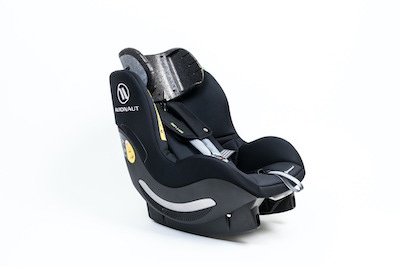Tepex continuous-fiber-reinforced thermoplastic composite materials from Lanxess used in child seat headrest; excellent crash performance and weight saving of up to 30 percent; particle-foam composite injection molding reduces number of parts.
March 12, 2020

Tepex continuous-fiber-reinforced thermoplastic composite materials from Lanxess have potential for use in many areas, including the lightweight construction of structural safety components. A child seat headrest that has been developed as a technology demonstrator serves to illustrate the opportunities on offer here.
|
Bild 1 Tepex_Preform Sitecore Internet Image4oox267.jpg The Tepex insert is formed in a single process operation using an injection molding tool with turning plate and back-injected with a short-glass-fiber-reinforced PP compound to integrate the support structure for the headrest and backrest, for example. Photo: Professur Strukturleichtbau und Kunststoffverarbeitung an der Technischen Universität Chemnitz |
|
Bild 2 PVSG-Kopfstuetze_mit_Kindersitz-Tepex_ Sitecore Internet Image4oox267.jpg The child seat headrest has been developed as a technology demonstrator and is produced in a particle-foam composite injection molding process. The Tepex insert can reduce the weight of the headrest by up to 30 percent in comparison with the commercial component variant – and with comparably good crash performance, too. Photo: Professur Strukturleichtbau und Kunststoffverarbeitung an der Technischen Universität Chemnitz |
The component is produced in a particle-foam composite injection molding (PCIM) process. “The insert made of Tepex can reduce the weight of the headrest by up to 30 percent in comparison with the commercially produced component variant – and with comparably good crash performance, too. It also simplifies the production process,” explains Klaus Vonberg, an expert in lightweight construction at the Tepex Automotive Group of the High Performance Materials (HPM) business unit at Lanxess. Tepex is developed and produced by Lanxess subsidiary Bond-Laminates GmbH.
The demonstrator is the result of a transnational research project funded by the German Federal Ministry for Economic Affairs and Energy as part of the Central Innovation Programme for Small and Medium-Sized Enterprises. The Department of Lightweight Structures and Polymer Technology (SLK) at Chemnitz University of Technology, Polycomb GmbH, and the child seat manufacturer Avionaut based in Szarlejka, Poland, are participating in this program.
For the headrest, the project partners developed an alternative production process based on PCIM. To reinforce the headrest in individual places and reduce weight, they used a customized insert made of Tepex dynalite 104-FG290(4)/47%. This is a polypropylene-based composite material that is strengthened with two layers of continuous-glass-fiber rovings. The insert is formed in a single process operation using an injection molding tool with turning plate and back-injected with a short-glass-fiber-reinforced polypropylene (PP) compound to integrate the support structure for the headrest and backrest, for example. The prefabricated insert is then back-foamed in a second tool using particle foam based on expanded polypropylene (EPP).
The existing headrest, by contrast, is produced in series using multiple individual components. The support structure consists of long-glass-fiber-reinforced PP. It is assembled with a separately foamed EPP component using four PP carrier pins. “Not only is the new, highly integrated production process more energy-efficient than the previous procedure, it also directly delivers the finished component. This reduces the total number of parts from six to one, which also lowers production costs in terms of logistics and the machine expenditure required,” explains Norbert Schramm, scientific assistant at the Chemnitz University of Technology. The weight saving with the current version of the headrest component featuring glass fiber is roughly 26 percent, although there is still potential for more. According to Schramm: “If a reinforcement based on carbon fibers is used in the composite semi-finished product and in the injection molding material, the result is an assembly that is almost 30 percent lighter.”
Lanxess sees a wealth of potential for Tepex and the new process in the production of infant carriers, backrests and armrests as well as seat shells for new, highly complex seating concepts in autonomous cars or for comfort seats for shuttle, VIP and family buses. Electric vehicles in particular would benefit from lightweight seats.
About the Author(s)
You May Also Like






